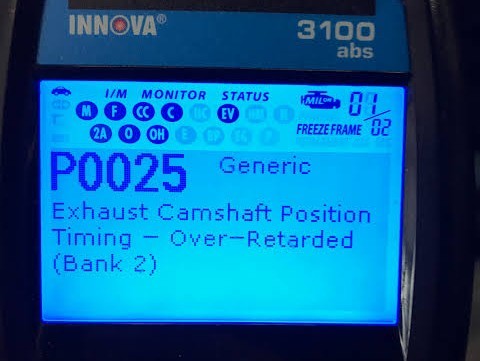P0025 is a diagnostic trouble code (DTC) that indicates a problem with the exhaust camshaft position timing on bank 2 of the engine.
The camshaft is responsible for opening and closing the valves in the engine, and the timing of this process affects the performance and efficiency of the engine. When the camshaft position timing is over-retarded, it means that the camshaft is opening the valves too late, which can cause reduced power, poor fuel economy, and increased emissions.
What Causes P0025 Code?
There are several possible causes for the P0025 code, such as:
- Incorrect camshaft timing due to a worn or stretched timing chain or belt
- Wiring problems or loose connections in the camshaft position sensor or solenoid circuits
- Faulty camshaft position sensor or solenoid
- Low oil pressure or dirty oil that prevents the proper operation of the variable valve timing (VVT) system
- Faulty VVT actuator or phaser
What are the Symptoms of P0025 Code?
The P0025 code may cause one or more of the following symptoms:
- Check engine light on
- Hard starting or stalling
- Rough idle or misfire
- Loss of power or acceleration
- Poor fuel economy or increased emissions
How to Diagnose and Repair P0025 Code?
To diagnose and repair the P0025 code, you will need a scan tool, a multimeter, and a repair manual for your specific vehicle make and model. Here are some general steps you can follow:
- Scan the vehicle for codes and note any other codes that are present along with P0025.
- Clear the codes and test drive the vehicle to see if P0025 returns.
- If P0025 returns, inspect the wiring and connectors of the camshaft position sensor and solenoid circuits for bank 2. Look for any signs of damage, corrosion, or loose connections. Repair or replace any faulty wires or connectors as needed.
- Check the resistance and voltage of the camshaft position sensor and solenoid for bank 2 using a multimeter. Compare your readings with the specifications in your repair manual. Replace any faulty components as needed.
- Check the oil level and condition and make sure it is clean and sufficient for the proper operation of the VVT system. Change the oil and filter if necessary.
- Check the timing chain or belt for any signs of wear or damage. If the timing chain or belt is loose, stretched, or broken, it may cause incorrect camshaft timing and trigger P0025. Replace the timing chain or belt as needed.
- Check the VVT actuator and phaser for bank 2 and make sure they are functioning properly. The VVT actuator is a solenoid that controls the oil flow to the VVT phaser, which is a device that adjusts the camshaft position angle. You may need to use a scan tool to activate the VVT actuator and monitor the camshaft position data. If the VVT actuator or phaser is stuck, clogged, or faulty, it may cause over-retarded camshaft timing and trigger P0025. Replace any faulty components as needed.
- Clear the codes and test drive the vehicle again to see if P0025 is resolved.
How to Prevent P0025 Code?
To prevent P0025 code from happening again, you should:
- Perform regular oil changes and use the correct type and grade of oil for your vehicle
- Follow the recommended maintenance schedule for your vehicle and replace the timing chain or belt as specified
- Inspect the wiring and connectors of the camshaft position sensor and solenoid circuits regularly and fix any issues as soon as possible
- Scan your vehicle periodically for any pending or stored codes and address them promptly
Conclusion
P0025 code is a common DTC that indicates a problem with the exhaust camshaft position timing on bank 2 of the engine. It can cause various performance issues and increase emissions. To fix it, you need to diagnose and repair the root cause of the problem, which could be related to the camshaft position sensor, solenoid, VVT system, wiring, oil, or timing chain or belt. By following these steps, you can resolve P0025 code and restore your vehicle’s optimal performance.

Comments (0)
Please login to join the discussion
Be the first to comment on this article!
Share your thoughts and start the discussion